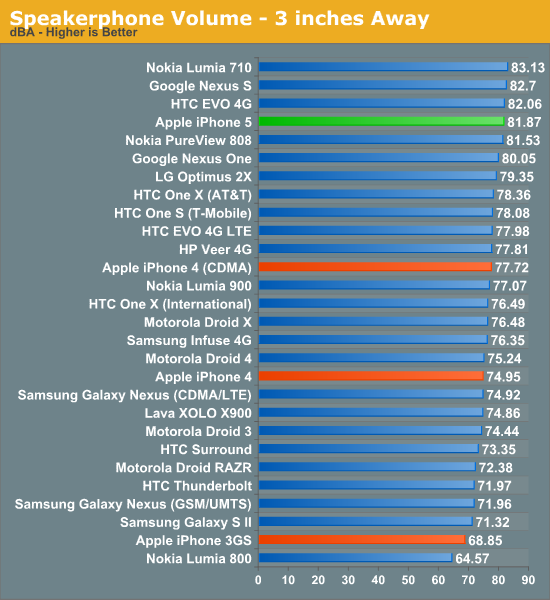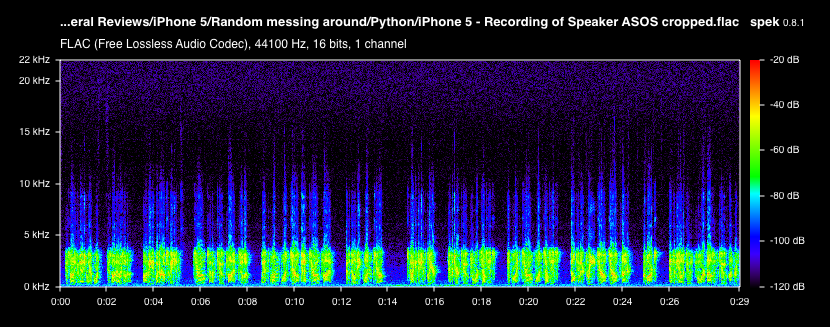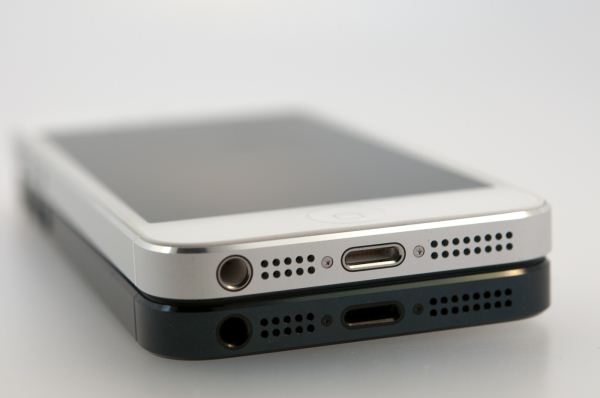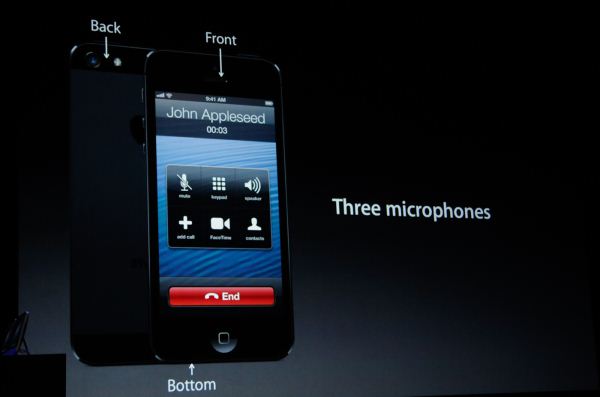The iPhone 5 Review
by Anand Lal Shimpi, Brian Klug & Vivek Gowri on October 16, 2012 11:33 AM EST- Posted in
- Smartphones
- Apple
- Mobile
- iPhone 5
Speakerphone and Noise Suppression
Section by Brian Klug
When Apple changed up the dock connector with the smaller Lightning port, it afforded a chance to also redesign the speakerphone at the bottom of the iPhone 5. Between the iPhone 4 and 4S we saw minimal changes, and performance was acceptable if a bit on the quiet side. With the iPhone 5 Apple advertised a big gain in audio quality with both changes to the speaker and a 5 magnet transducer design.
We normally test speakerphones by calling the local ASOS test number at max volume in front of an Extech sound data logger sampling continually and then averaging over one readout of the weather report. This gives a good feel for the overall loudness of the speakerphone on a call, but doesn’t tell us anything about quality unless you’re standing in front of it. In this case, the iPhone 5 is quite loud and comes in near the top of our scale at 81.8 dBA. It isn’t chart topping but a definite improvement over the relatively quiet 4/4S speakerphone design.

I decided to do something different though after getting a lot of questions and emails asking for a better quality comparison between the iPhone 5 speaker and its predecessor. People are interested in using their smartphones to listen to music when speakers or a dock aren’t available, and I thought this worth investigating. To get to the bottom of this I used my Blue Yeti USB microphone and arm which I use for podcasting to record the speakerphone output at 90 percent volume on the iPhone 4S and iPhone 5.
I started with the test call, which sounds surprisingly different between the iPhone 4S and iPhone 5. The 4S saturates and has obvious distortion even at 90 percent volume. This is quite noticeable in the recording. It then occurred to me that because I’m calling over AT&T (narrowband AMR) and to a PSTN (public switched telephone network) that the call would be limited to 4 kHz thanks to filters along the route, therefore anything above 4 kHz is undesirable. I took a spectral analysis (which shows power spectral density), and instantly it became obvious just how much energy there is on the 4S above the 4kHz limit from overmodulation or saturation/clipping on that speakerphone design. Meanwhile the iPhone 5 has much less energy over that 4 kHz maximum for a PSTN call.
I did the same for two songs recorded start to finish, and the differences are quite noticeable even in my rather quick and dirty recording plus spectogram comparison. I cropped the two recordings of the songs quite a bit and stuck them on soundcloud.

My overall impressions with the iPhone 5 speakerphone is that it has much less of a tendency to clip and saturate than the 4S, all while being noticeably louder. It’s still a smartphone speakerphone but to my ears the difference is pretty dramatic.
Noise Suppression
We’ve known for a while now that Apple changed up the slot for noise cancellation in the iPhone 5. The story goes something like this — Audience was a discrete chip on the iPhone 4, an IP block on the A5 SoC for iPhone 4S, and also an IP block onboard the A6 SoC for iPhone 5. The difference is that with iPhone 5 Audience isn’t enabled, and the company knows this because final characterization with both the final industrial design, microphones, and performance was never performed. Audience claims it met all of its deliverables and targets with the new IP block it built and gave Apple for inclusion on the A6. There’s obviously a lot of speculation about exactly why Apple chose to go with its own soultion versus Audience.
We’ve seen Audience earSmart noise suppression processors in a number of smartphones to date, and carriers often have their own specification for noise suppression to get certified. In addition, with wideband voice (AMR-WB in the case of the iPhone 5) noise suppression is even more important, to say nothing of how big of a topic this is with voice recognition based features like Siri. While we’re on the subject of AMR-WB, this feature is enabled on the iPhone 5 but I’m unable to test it on any of the carriers in the USA at the moment.
Anyhow, the iPhone 5 uses an Apple-specific solution with three total microphones all around the device. One primary microphone at the bottom of the device where you’d expect the primary microphone to reside, a secondary microphone between the LED flash and camera module, and a third right next to the earpiece for use with earpiece active noise cancelation. Apple’s solution is a beamformer (Apple said so in the keynote) and from what I can tell thus works entirely in the time domain. I’ve spent a lot of time playing around with the iPhone 5 trying to characterize its noise rejection, and the system appears to have a number of modes it will kick into after a 5–10 second adaptation time.
Earpiece noise rejection is something I talked about on the podcast right after the iPhone 5 hands on, and is one of those modes that the iPhone 5 will kick into if you’re in a loud environment. It isn’t active all the time, but when it does transition into working it provides a noticeable suppression of ambient noise and the same kind of pressure I’ve felt with other active noise canceling closed ear headphones. The improvement isn’t overwhelming, but it’s a sensation and feature I haven’t experienced on any other smartphones to date.
The rest of the noise suppression story is really one of testing. To test, I ran our normal test suite which consists of me ramping ambient music to 94 dBA while speaking into the device under test and recording the other side of the call. I’ve gotten ahold of the industry standard babble and distractor tracks used by carriers for testing noise suppression and will move to those in the future, for now though the test track I currently play is something I understand pretty well.
The comparison here is between the iPhone 4S and iPhone 5 to see just how ambient noise suppression has changed with this change in solution. The difference in technique is pretty apparent, and again indicates to me that the iPhone 5 is working in the time domain. You can see visible cut in and cut out on the waveform. The Audience solution has some hiss that develops at the absolute highest background noise volume on the 4S, but it also does an excellent job suppressing noise. The Apple solution doesn’t have this hiss, but passes both background noise and vocals from the music passed through the call at maximum volume. I hate to call this a regression, but the difference in technique means that there’s audible background noise that gets passed on while I’m talking on the iPhone 5. I think for normal callers the difference won’t be readily apparent, but with close inspection it is dramatic.













276 Comments
View All Comments
A5 - Tuesday, October 16, 2012 - link
Double the browsing time while moving to LTE and roughly the same in everything else despite double the performance is pretty impressive.rarson - Thursday, October 18, 2012 - link
I'm pretty sure they mentioned about a million times that "this is the new paradigm blah blah blah, where if you use heavy processing power more often, the battery life will diminish faster" (I'm paraphrasing here). I'm fine with that. The iPhone 5 shows some pretty impressive battery life in light workloads and doesn't actually do all that bad in heavy workloads despite how much number crunching it's doing, even though it might actually tank the battery life down to less-than-4S levels.It's a tradeoff: you get more power or longer battery life, depending on how you use it. The article paints this as a bad thing, but I disagree; it's obviously making much more efficient use of the hardware. Because of that, I definitely think the battery life overall is better, even though sometimes it might be worse. And you're still getting a lot more number crunching for the watts used.
Center - Tuesday, October 16, 2012 - link
In the intro, the screen specs on the iphone 5 is listed as 1136x960.. should be 1136x640.But great article as always, Anandtech!
Krysto - Tuesday, October 16, 2012 - link
I hope we'll see the same kind of thorough review of Samsung's Exynos 5 Dual chip, Anand.ltcommanderdata - Tuesday, October 16, 2012 - link
Isn't TI supposed to become the first shipping Cortex A15 SoC? I expect Anandtech to thoroughly review the first Cortex A15 SoC. There shouldn't be a need to go into the same detail (on the CPU side) for every subsequent one unless preliminary tests show something significantly different.Kidster3001 - Monday, October 22, 2012 - link
Samsung and Qualcomm do not ship generic ARM chips. They purchase licenses to use the ARM instruction set, not the chip design. Their chips are highly customized and perform differently.Using your logic to just review the first A15 class chip and consider the rest to be comparable is similar to just reviewing the first new car to be released every year and assume the rest will be comparable.
btw, TI is getting out of the business. I doubt they will ship first, or ever.
A5 - Tuesday, October 16, 2012 - link
Considering the fact that Krait got several articles here, I'd imagine that whatever the first shipping A15 chip is will get significant coverage.Wurzelsepp - Tuesday, October 16, 2012 - link
Great review, you really have to give Apple credit for building an amazing SoC.It's interesting to see how well the Adreno competes with SGX-543MP3, the new Nexus 4 with this GPU is going to be amazing.
Krysto - Tuesday, October 16, 2012 - link
One thing both the iPhone and the Intel Atom processors will keep lacking for a year from now, will be OpenGL ES 3.0 support. Apple might bring it to the new iPad 4 this spring, but the iPhone won't have it until the next iPhone, in the fall of 2013, obviously. Same with Intel, they won't be supporting it at least until end of 2013.In the meantime both Adreno 320 and Mali T604 are supporting it, and will come out this fall.
darwinosx - Tuesday, October 16, 2012 - link
A year from now and something 'coming out this fall". Right.